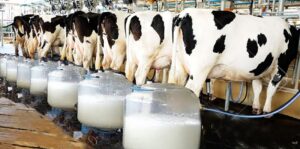ANIMAL HUSBANDRY- AN OVERVIEW
In agriculture, husbandry means the cultivation of plants or animals.
Animal Husbandry is the branch of agriculture which refers to raising of animals for meat, fibre, milk, or other products. Animals provide us with a variety of food products which have high nutritional values. Therefore, they require well care and attention.
Husbandry includes the breeding, management and care of animals in which the genetic qualities and traits of animals are further developed for maximization of profit.
Farmers and ranchers who raise livestock are considered to practice animal husbandry.
History
Husbandry has a long history, starting with the Neolithic Revolution when animals were first domesticated. By the time of early civilisations cattle, sheep, goats, and pigs were being raised on farms.
The domestication of livestock was needed in order to get food to everyone as hunting become unproductive. The first wild animal domesticated was the dog. Later on, Prey animals, sheep, goats, pigs and cattle, were domesticated early in the history of agriculture.
Pigs were domesticated between 8,500 and 8000 BC, sheep and goats in about 8,500 BC, while cattle from wild aurochs in the areas of modern Turkey and Pakistan around 8,500 BC.
Draught animals were first used about 4,000 BC in the Middle East that increased the agricultural production.
Traditionally, animal husbandry was part of the subsistence farmer’s way of life because it provided not only the food needed by the family but also the fuel, fertiliser, clothing, transport and draught power. Progressively secondary considerations were products such as wool, eggs, milk etc. harvested.
Extensive and Intensive system
Animals can be kept extensively or intensively or combined of both called semi-intensive.
In the Extensive systems animals roams freely or under the supervision of a herdsman. Ranching involves large herds of cattle grazing widely over public and private lands. This system has been used for sheep, deer, ostrich and other animals.
In intensive system dairy cows may be kept in no-grazing conditions with all their forage brought to them, pigs may be housed in climate-controlled buildings and never go outdoors, poultry may be reared in barns and kept in cages as laying birds under lighting-controlled conditions.
Semi-intensive is often family-run farms where livestock graze outside for much of the year whereas, silage or hay is made to cover off season when the grass stops growing, and fertiliser, feed, and other inputs are brought onto the farm from outside.
Feeding Livestock Animals
Livestock animals are predominantly herbivorous however; pig and the chicken are omnivorous. The herbivores may be “concentrate selectors” feed on seeds, fruits and highly nutritious young foliage, or “grazers” which mainly feed on grass, or may be “intermediate feeders” which choose their diet from the whole range of available plant material.
Extensively reared animals may subsist entirely on forage, but more intensively kept livestock will require energy and protein-rich foods in addition. Energy is mainly derived from cereals and cereal by-products, fats and oils and sugar-rich foods, while protein may come from fish or meat meal, milk products, legumes and other plant foods.
Non-ruminants (Pigs and poultry) are unable to digest the cellulose in grass and other forages, so they are fed entirely on cereals and other high-energy foodstuffs.
The breeding of farm animals is managed by farmers with a view to develop desirable traits such as hardiness, fertility, mothering abilities, fast growth rates, better body proportions, higher yields, and better fibre qualities.
Selective breeding has been responsible for large increases in productivity.
Branches of Animal Husbandry
- Dairy farming
- Poultry
- Aquaculture– defined as “the farming of aquatic organisms including fish (pisciculture), molluscs, crustaceans and aquatic plants.
- Insects– Bees for honey production (Apiculture), also utilize as pollinator. Sericulture is the rearing of silkworms.
Role and Advantage of Animal Husbandry
The different types of Animal husbandry are beneficial to human beings in various ways:
Dairy Products
Animals such as cows, goats, sheep, etc. are the major source of milk and milk products such as yoghurt, cheese, butter, ghee etc.

Meat
Cows, buffaloes, pigs, and goats are reared for their meat. Their meat is a rich source of dietary protein.
Fibre
Animals like sheep, camel also produce fibres or textiles such as wool and leather.
Manure
The excreta, blood and bones of animals are used as manure. Excreta are also source of fuel for villagers.
Drought purpose
Different animals are used for ploughing fields, transporting goods. Cattle, horses, yaks and donkeys are used for such purposes.
Advantages
- It provides employment to a large number of farmers and thereby increases their earnings and living standards.
- It helps in developing high yielding breeds of animals by cross breeding. This increases the production of various food products such as milk, eggs, meat, etc.
- Farmers get manure, fuel, wool and other products from the animal husbandry.
- Animal husbandry is concerned with proper caring, management and breeding of animals. It provides shelter and desirable environment to animals for their health.
- It involves the proper disposal of animal waste and promotes a healthy environment.
Read also…
ANIMAL TERMINOLOGY- LIVESTOCK PRODUCTION
ANIMAL HUSBANDRY MCQ PART 1